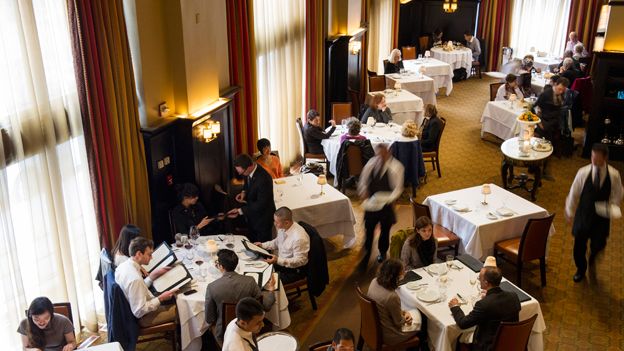The Carbone waiters are dressed in maroon tudos, somewhat like the one Ryan Gosling wore at the 2011 Cannes Film Festival. They speak in calculatingly cutesy Italian-American patois. Many of their sentences begin, “Ya know…” Once you reply, they confirm with a “Ya got it.” (The word “you” is practically unknown to them.) The female waiters wear a variation on the theme of maroon, but I haven’t been served by one, so I don’t know if they also speak a lost language last heard a half-century ago. I like the waiters at Carbone. They’re very good at what they do. But I am not amused by their cartoonish language skills.
The floors at Carbone are black-and-white tile, very Bronx. There are brilliant flower arrangements in the front room. The bread plates are colorful tourist pottery. (They’re started to chip, as tourist pottery inevitably does.) Almost every Italian-American restaurant in New York is past its prime, as dispirited and broken down as Al Pacino at the conclusion of The Godfather: Part II. Carbone is bright, shiny, and uplifting. The food is very expensive, not a problem for power lunchers, although even they might balk at $85 for lobster fra diavolo. While Italian-American food has the image of being goopy and disproportionately heavy, it isn’t that way here.
The garlic bread is moderate in heft but vigorous in flavor, exactly right. The tortellini with ragù is a tour de force of Italian-American delicacy. The pasta rings are stuffed with sheep’s milk ricotta and sit atop a creamy, pale, old-fashioned red sauce made with beef, veal, pork and lardo. Every cook working in Little Italy should be required by law to sample it. The Caprese salad, routine elsewhere, here consists of basil-flecked heirloom tomatoes in olive oil with a side of warm, fresh mozzarella. I would think no restaurant could pull off just-made mozzarella, but if this is simply mozzarella warmed up, it fooled me.
Veal parmigiana, the signature dish, was shared by three of us. It was rounded off and cut into wedges using a pizza slicer. The beet salad is a beauty, the mushroom pasta unexpectedly subtle, the gently pan-crisped halibut totally modern, served with a scattering of vegetables, including fragile squash-blossom leaves. Usually squash blossoms are stuffed with cheese and possess the heft of bocce balls.
Del Posto is owned by Mario, Joe, and Lidia—you know who I mean. It has never been beloved for its décor, which is gold-hued, dark-paneled, and softly lit. Walk in and you are greeted by a young woman who radiates friendliness. She does not know you. You do not know her. She knew me, but only because we used to work together. The dining room is filled with nooks and crannies, nice for a romantic dinner, perhaps even okay for a new-age power lunch. There’s also an abundance of open space.
Del Posto is one of the best Italian restaurants in the country. As opposed to Carbone, its lunch is ridiculously underpriced, starting at $39 for a three-course meal. The menu options are complicated, and the supplements within the menus extensive. That’s a bit of a problem. It’s fine for bargain hunters and gastronomes, but people working out multi-million dollar power-lunch deals do not wish to be distracted by ten-dollar decisions.


Dining and Cooking